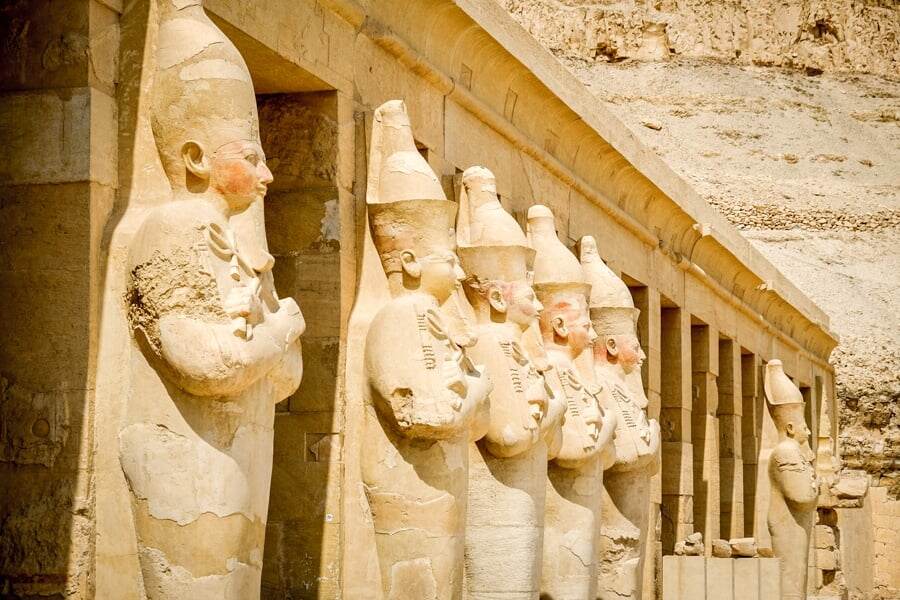Cultural, historical, adventure, and custom customized trips are just a few of the tours that Deluxe trips offer in Egypt and Jordan.

Situated beneath the scenic cliffs of Deir el-Bahari in Luxor, Mortuary Temple of Hatshepsut is one of the greatest and architecturally unique monuments of ancient Egypt. It is dedicated to one of Egypt's extremely rare female pharaohs, Queen Hatshepsut, a temple that bears testament to the grandeur of New Kingdom architecture but also to an extraordinary and mighty ruler.
In this blog, we’ll explore the historical significance, architectural marvels, and visitor tips for discovering the Temple of Hatshepsut, one of Egypt’s most iconic ancient attractions.
Hatshepsut was one of the greatest pharaohs of the old Egyptian era and particularly the longest reigning woman. She reigned during the 18th dynasty (c. 1479–1458 BCE) and defied the usual convention of becoming the sole ruler of a male pharaoh. Her reign was one of peace, massive building constructions, and trade expansion.
To put herself on the pages of history, Hatshepsut commissioned that her mortuary temple should be built out of the face of western Thebes—present-day Deir el-Bahari, near the Valley of the Kings.
Commissioned by Hatshepsut's royal architect and administrator Senenmut, it is an architectural marvel. The design of this temple is quite unlike all other contemporary temples.
Three tiers of sloping terraces into the face of the cliff, connected by extremely long ramps
Porticoes with colonnaded rows of thin, tall columns
Beautiful reliefs and inscriptions depicting Hatshepsut's divine conception, foreign-trade expeditions (such as the famous journey to Punt), and achievements
Temples dedicated to Amun-Ra and other deities
The temple seems to blend harmoniously into the landscape, producing an agreeable visual impression that was quite revolutionary for temple architecture in ancient Egypt.
Since it was a mortuary temple, it was both religious and political. It was where priests performed rituals and offerings to safeguard Hatshepsut in the afterlife, as well as confirming her divine right to reign.
Temple structure points towards the sun and is oriented with horizontal religious rituals on Ra, the deity of the sun. Its wall mural of the divine birth itself was an obligatory political agenda statement to emphasize that Hatshepsut was appointed by the gods to be the ruler of Egypt.
Now, The Birth Colonnade – Stunningly well-preserved reliefs showing the divine conception and birth of Hatshepsut to the god Amun.
Punt Expedition Reliefs – Scenes of Hatshepsut's mission to the mysterious land of Punt, including exotic architecture, incense trees, and foreign animals.
Statues of Osiris – At the topmost level of the mortuary temple, these statues symbolize resurrection and divine rule.
Sanctuary of Amun – Inner chamber of restricted dimensions dedicated to religious rituals, particularly sacred to Hatshepsut's patron god.
The temple is part of the standard Luxor day trips, normally combined with other West Bank attractions including Valley of the Kings, Colossi of Memnon, and the Ramesseum.
Best time to visit early morning to miss tourists and sun.
Cover head with a hat, apply sunscreen, and drink plenty of water, especially during summer.
Take some time to study the hieroglyphic inscriptions or take the services of a local Egyptologist guide for greater insight.
No matter how hard her later pharaoh successors attempted to erase her from history, Queen Hatshepsut's records survive in this imposing temple. It is a testament to her intelligence, her authority, and her sense of style.
A tour highlight in Luxor, the Mortuary Temple of Hatshepsut is more than bricks and mortar—it is a glimpse into one of history's most intriguing governors.
Discover now our answers to the most common questions that may come to your mind about tourism and trips to Egypt
Cultural, historical, adventure, and custom customized trips are just a few of the tours that Deluxe trips offer in Egypt and Jordan.
The Dead Sea, Petra in Jordan, the Pyramids of Giza, Luxor's historic temples, and many other famous sites can be expected to be explored with Deluxe Tours.
offer a hassle-free holiday, Deluxe Tours' packages generally include lodging, transport, meals, guided tours with experienced local experts, and entry fees to attractions.
Spring (March to May) and fall (September to November) offer the finest weather for sightseeing and outdoor activities, making those months the best times to visit Egypt and Jordan.
These two countries are close by, only a 1.5-hour flight apart, and when combined, offer a variety of distinctive experiences. We advise you to spend at least 12 days visiting both countries for a truly unforgettable experience
Combining the eclipse viewing with visits to historic sites like the Pyramids of Giza, the Valley of the Kings, and a Nile River cruise are highly recommended.
